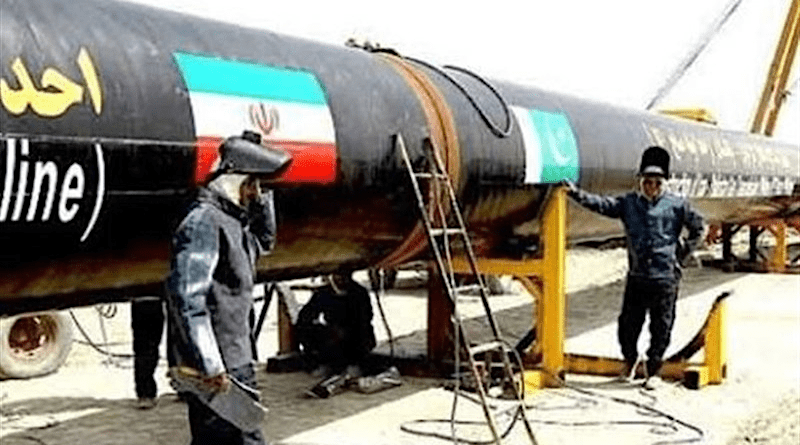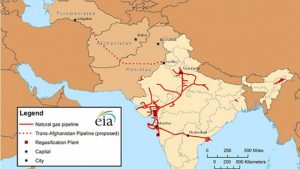‘Peace Gas Pipelines’: Dead Or Alive? – OpEd
By Patial RC
Iran and Pakistan have agreed to forge deeper cooperation as they decided to expedite the process of inking a free trade agreement (FTA), convert their common frontier into a “Border of peace and Friendship,” according to the joint statement. They also reiterated the importance of cooperation in the energy domain, including trade in electricity, power transmission lines and Iran-Pakistan (IP) Gas Pipeline Project. The Iranian president was the first head of state from Iran to visit Pakistan since 2017 after the recent dual of missile attacks on each other!
Pakistan has temporarily shelved the multi-billion-dollar gas pipeline project to import cheap energy from neighbouring Iran, apparently under pressure from the US which has imposed sanctions against Tehran over its nuclear programme, according to a media report. The US State Department has warned Pakistan that Washington does not support the Iran-Pakistan gas pipeline going forward, and Islamabad risks coming under US sanctions if it pursues the IP Gas Pipeline project.
It was widely expected that the leaders of both countries would in their meetings discuss the fate of the stalled IP gas pipeline especially after Islamabad earlier this year decided to construct an 80 km line within its territory to pre-empt Tehran from initiating arbitration in international courts that could potentially lead to a penalty of $18 billion. Iran’s proven natural gas reserves, estimated at 1,203 trillion cubic feet as of December 2021, are second only to Russia.
IP Gas Pipeline – ‘Peace Gas Pipeline.’ The long-term project, which came to be known as the ‘Peace Pipeline’, has faced significant delays due to geopolitical pressures, sanctions on Iran and financial hurdles within Pakistan.
- IP Gas Pipeline Project deal, signed in 2010, envisaged the supply of 750 million to a billion cubic feet per day of natural gas for 25 years from Iran’s South Pars gas field to Pakistan to meet Pakistan’s rising energy needs.
- The pipeline was to stretch over 1,900 km. 1,150 km within Iran and 781 km within Pakistan.
- Iran has already invested $2 billion to construct the pipeline on its side of the border, making it ready to export. A ceremony was jointly conducted by then presidents Asif Ali Zardari and Mahmoud Ahmadinejad on the Iranian site near Chabahar in March 2013.
- Pakistan is yet to commence the construction and the deal is said to be off for the time being, citing US sanctions on Iran over its nuclear programme.
- Pakistan has yet to acquire the land in Gwadar earmarked for construction.
- The project was initially conceived as an India-Pakistan-Iran gas pipeline, but later, India left and it is now a bilateral project between Iran and Pakistan.
- Iranian Foreign Minister during his three-day visit to Pakistan in April 2024, emphasised the need for the completion of the project, saying it would definitely serve the national interests of the two countries.
- “Russia has offered to fund the initial $160m for the 80km of Pakistan-Iran pipeline.” Iran has offered to provide technical and engineering support in building the pipeline.
The Government of Pakistan is believed to be engaged with the US authorities, through diplomatic channels, to seek waiver for sanctions to proceed with the project. Petroleum Minister told journalists last month that “We cannot bear American sanctions. We will present our stance to the US. Iran has been told multiple times that we need their gas. We want to complete this project but without any sanctions.” As tensions now mount in the Middle East over the war in Gaza, with new US sanctions against Iran announced on April 18, it was unlikely that the US would grant Pakistan a waiver.
TAPI Gas Pipeline. Turkmenistan-Afghanistan-Pakistan-India (TAPI) project is one of the largest gas pipeline initiatives in the region. It aims to transport 33 billion cubic meters of natural gas from Turkmenistan to Pakistan and India through Afghanistan:
- Originally launched in 2016 with a planned completion date of 2019, the project faced delays due to various challenges, including the resurgence of the Taliban in the region.
- The 1800 km pipeline, with 735 kilometers passing through Afghanistan, 215 km in Turkmenistan and 826 km in Pakistan and finally ending in Fazilka, India.
- It is expected to generate more than $200 million in annual revenue for Afghanistan and create approximately 12,000 new jobs.
- The Taliban has announced its readiness to begin construction on the TAPI gas pipeline project.
- The US had promoted the TAPI gas pipeline project, it had tried to discourage India and Pakistan from any deal with Iran in the past, because of Tehran’s suspected ambitions to build nuclear arms.
The foreign ministers of the Taliban and Turkmenistan during their recent meeting discussed the TAPI project and explored ways to enhance trade relations, cooperate in the railway sector, and increase electricity imports to Afghanistan.
Pakistan, one of the four partners in the Turkmenistan-Afghanistan-Pakistan-India natural gas pipeline project, is expected to get final approvals by the end of the second quarter of 2024 to clear the way for construction to begin according to sources. Even if approved Pakistan is likely to defer till the implementation is completed to some extent in Afghanistan and not before US allows. The TAPI pipeline is likely to supply Pakistan with 1.3 Bcf of gas, to meet a need for supplies to the country’s expanding population and economic growth.
Piped gas from Iran by most estimates is the cheapest option of gas imports to Pakistan or India. Given the transit fees that Pakistan stands to earn and corresponding dependence on petro products from India renewed efforts are required to revive the peace pipeline that has so far remained a pipe dream because of America’s opposition and linked to sanctions.
Between the threat of US sanctions on one side and possible Iranian penalties on the other and funding problems wonder if the IP ‘Peace Pipeline’ will get off to start in Pakistan. “Pakistan is seemingly caught between the devil (US) and the deep blue sea (Iran) to build the pipeline and risk being sanctioned by the US, or don’t build it and get slapped with a massive fine by Iran.”
US is known to use the ‘Carrot and Stick’ policy often in Pakistan and is believed to have been used against India also to keep it away from the IP while offering provision of nuclear energy as an alternative of Iranian gas. Mr. Mukherjee had then said that “The nuclear deal with the US would have no impact on the IPI gas pipeline, as India’s energy requirement is quite substantial and we have to locate various sources of energy, including civil nuclear cooperation with countries like the US, France and Russia or any other country willing to cooperate with us.”
IP or TAPI the so called ‘Peace Gas Pipelines’ pass-through Taliban infested Afghanistan and Pakistan. The security issues will continue to exist even if implemented in due course. Funding is another major issue. Both the projects IP and TAPI gas pipelines have only been completed in the respective starting countries Iran and Turkmenistan the suppliers of gas from their gas fields. The implementation of both projects in the distant future appears to be bleak, especially with the ongoing crisis in the Middle East over the war in Gaza.
“It may be dangerous to be America’s enemy, but to be America’s friend is fatal.” — Henry Kissinger


